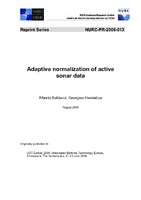| dc.contributor.author | Baldacci, Alberto | |
| dc.contributor.author | Haralabus, Georgios | |
| dc.date.accessioned | 2018-10-11T14:09:27Z | |
| dc.date.available | 2018-10-11T14:09:27Z | |
| dc.date.issued | 2006/08 | |
| dc.identifier | 24990 | |
| dc.identifier.govdoc | NURC-PR-2006-013 | |
| dc.identifier.uri | http://hdl.handle.net/20.500.12489/603 | |
| dc.description.abstract | In active sonar detection the background interference is reduced through normalization prior to applying a detection threshold. From the two mainstream normalization algorithms, i.e. the sliding window and the split window, the latter places guard bands around the point of interest to avoid a spill of the target's energy into the background calculation. The size of the guard bands has a strong effect on normalization: if it is too narrow, the target's energy biases the background estimation; if it is too large, the background estimate at one location is based on background samples too far away from that point. During recent sea trials strong changes in system performance, attributed to inappropriate normalization, have been experienced. An approach to overcome this problem by means of an adaptive normalization window that takes into account the geometry of the scenario and the environmental conditions (time spreading) is presented. | |
| dc.format | 9 p. : ill. : digital, PDF file | |
| dc.language | English | |
| dc.publisher | NURC | |
| dc.source | In: UDT Europe 2005, Underwater Defence Technology Europe, Amsterdam, The Netherlands, 21-23 June 2005 | |
| dc.subject | Ray tracing | |
| dc.subject | Active sonar | |
| dc.subject | Signal processing | |
| dc.title | Adaptive normalization of active sonar data | |
| dc.type | Reprint (PR) | |
| dc.type | Papers and Articles | |
